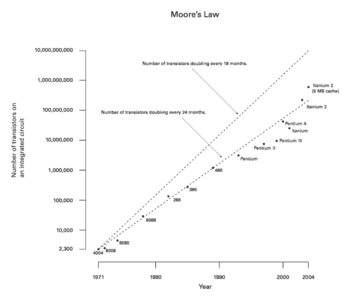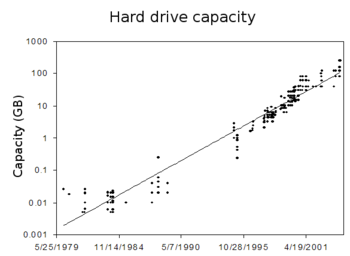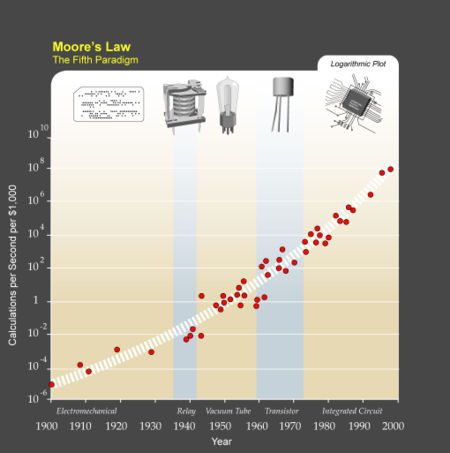Moore's Law
2007 Schools Wikipedia Selection. Related subjects: Computing hardware and infrastructure
Moore's Law is the empirical observation made in 1965 that the number of transistors on an integrated circuit for minimum component cost doubles every 24 months. It is attributed to Gordon E. Moore (1929 —), a co-founder of Intel.
Earliest forms
The term Moore's Law has been coined by Carver Mead around 1970 . Moore's original statement can be found in his publication "Cramming more components onto integrated circuits", Electronics Magazine 19 April 1965 :
| The complexity for minimum component costs has increased at a rate of roughly a factor of two per year ... Certainly over the short term this rate can be expected to continue, if not to increase. Over the longer term, the rate of increase is a bit more uncertain, although there is no reason to believe it will not remain nearly constant for at least 10 years. That means by 1975, the number of components per integrated circuit for minimum cost will be 65,000. I believe that such a large circuit can be built on a single wafer. |
Under the assumption that chip "complexity" is proportional to the number of transistors, regardless of what they do, the law has largely held the test of time to date. However, one could argue that the per-transistor complexity is less in large RAM cache arrays than in execution units. From this perspective, the validity of one formulation of Moore's Law may be more questionable.
Gordon Moore's observation was not named a "law" by Moore himself, but by the Caltech professor, VLSI pioneer, and entrepreneur Carver Mead.
Moore may have heard Douglas Engelbart, a co- inventor of today's mechanical computer mouse, discuss the projected downscaling of integrated circuit size in a 1960 lecture. In 1975, Moore projected a doubling only every two years. He is adamant that he himself never said "every 18 months", but that is how it has been quoted. The SEMATECH roadmap follows a 24 month cycle.
In April 2005 Intel offered $10,000 to purchase a copy of the original Electronics Magazine.
Understanding Moore's Law
Moore's law is not about just the density of transistors that can be achieved, but about the density of transistors at which the cost per transistor is the lowest . As more transistors are made on a chip the cost to make each transistor reduces but the chance that the chip will not work due to a defect rises. If the rising cost of discarded non working chips is balanced against the reducing cost per transistor of larger chips, then as Moore observed in 1965 there is an number of transistors or complexity at which "a minimum cost" is achieved. He further observed that as transistors were made smaller through advances in photolithography this number would increase "a rate of roughly a factor of two per year" .
Formulations of Moore's Law
The most popular formulation is of the doubling of the number of transistors on integrated circuits (a rough measure of computer processing power) every 18 months. At the end of the 1970s, Moore's Law became known as the limit for the number of transistors on the most complex chips. However, it is also common to cite Moore's Law to refer to the rapidly continuing advance in computing power per unit cost.
A similar law has held for hard disk storage cost per unit of information. The rate of progression in disk storage over the past decades has actually sped up more than once, corresponding to the utilization of error correcting codes, the magnetoresistive effect and the giant magnetoresistive effect. The current rate of increase in hard drive capacity is roughly similar to the rate of increase in transistor count. However, recent trends show that this rate is dropping, and has not been met for the last three years. See Hard disk capacity.
Another version states that RAM storage capacity increases at the same rate as processing power.
An industry driver
Although Moore's Law was initially made in the form of an observation and forecast, the more widely it became accepted, the more it served as a goal for an entire industry. This drove both marketing and engineering departments of semiconductor manufacturers to focus enormous energy aiming for the specified increase in processing power that it was presumed one or more of their competitors would soon actually attain. In this regard, it can be viewed as a self-fulfilling prophecy.
The implications of Moore's Law for computer component suppliers are very significant. A typical major design project (such as an all-new CPU or hard drive) takes between two and five years to reach production-ready status. In consequence, component manufacturers face enormous timescale pressures—just a few weeks of delay in a major project can spell the difference between great success and massive losses, even bankruptcy. Expressed as "a doubling every 18 months", Moore's Law suggests the phenomenal progress of technology in recent years. Expressed on a shorter timescale, however, Moore's Law equates to an average performance improvement in the industry as a whole of over 1% per week. For a manufacturer competing in the competitive CPU market, a new product that is expected to take three years to develop and is just two or three months late is 10 to 15% slower, bulkier, or lower in storage capacity than the directly competing products, and is usually unsellable.
Future trends
As of Q1 2006, current PC processors are fabricated at the 90 nm level and 65 nm chips are being introduced by Intel ( Pentium D & Intel Core). A decade ago, chips were built at a 500 nm level. Companies are working on using nanotechnology to solve the complex engineering problems involved in producing chips at the 45 nm, 30 nm, and even smaller levels—a process that will postpone the industry meeting the limits of Moore's Law.
Recent computer industry technology "roadmaps" predict (as of 2001) that Moore's Law will continue for several chip generations. Depending on the doubling time used in the calculations, this could mean up to 100 fold increase in transistor counts on a chip in a decade. The semiconductor industry technology roadmap uses a three-year doubling time for microprocessors, leading to about nine-fold increase in a decade.
In early 2006 IBM researchers announced that they had developed a technique to print circuitry only 29.9 nm wide using deep-ultraviolet (DUV, 193-nanometer) optical lithography. IBM claims that this technique may allow chipmakers to use current methods for seven years while continuing to achieve results predicted by Moore's Law. New methods that can achieve smaller circuits are predicted to be substantially more expensive.
Since the rapid exponential improvement could (in theory) put 100 GHz personal computers in every home and 20 GHz devices in every pocket, some commentators have speculated that sooner or later computers will meet or exceed any conceivable need for computation. This is only true for some problems—there are others where exponential increases in processing power are matched or exceeded by exponential increases in complexity as the problem size increases. See computational complexity theory and complexity classes P and NP for a (somewhat theoretical) discussion of such problems, which occur very commonly in applications such as scheduling.
The exponential increase in frequency of operation as the only method of increasing computation speed is misleading. What matters is the exponential increase in useful work (or instructions) executed per unit time. In fact, newer processors are actually being made at lower clock speeds, with focus on larger caches and multiple computing cores. The reason for this is that higher clock speeds correspond to exponential increases in temperature, such that it becomes almost impossible to produce a CPU that runs reliably at speeds higher than 4.3 GHz or so.
Extrapolation partly based on Moore's Law has led futurists such as Vernor Vinge, Bruce Sterling, and Ray Kurzweil to speculate about a technological singularity. However, on April 13, 2005, Gordon Moore himself stated in an interview that the law may not hold for too long, since transistors may reach the limits of miniaturization at atomic levels.
| In terms of size [of transistor] you can see that we're approaching the size of atoms which is a fundamental barrier, but it'll be two or three generations before we get that far—but that's as far out as we've ever been able to see. We have another 10 to 20 years before we reach a fundamental limit. By then they'll be able to make bigger chips and have transistor budgets in the billions. |
While this time horizon for Moore's Law scaling is possible, it does not come without underlying engineering challenges. One of the major challenges in integrated circuits that use nanoscale transistors is increase in parameter variation and leakage currents. As a result of variation and leakage, the design margins available to do predictive design is becoming harder and additionally such systems dissipate considerable power even when not switching. Adaptive and statistical design along with leakage power reduction is critical to sustain scaling of CMOS. A good treatment of these topics is covered in Leakage in Nanometer CMOS Technologies. Other scaling challenges include:
- The ability to control parasitic resistance and capacitance in transistors,
- The ability to reduce resistance and capacitance in electrical interconnects,
- The ability to maintain proper transistor electrostatics that allow the gate terminal to control the ON/OFF behaviour,
- Increasing effect of line edge roughness,
- Dopant fluctuations,
- System level power delivery,
- Thermal design to effectively handle the dissipation of delivered power, and
- Solve all these challenges with ever-reducing cost of manufacturing of the overall system.
Kurzweil projects that a continuation of Moore's Law until 2019 will result in transistor features just a few atoms in width. Although this means that the strategy of ever finer photolithography will have run its course, he speculates that this does not mean the end of Moore's Law:
| Moore's Law of Integrated Circuits was not the first, but the fifth paradigm to provide accelerating price-performance. Computing devices have been consistently multiplying in power (per unit of time) from the mechanical calculating devices used in the 1890 US Census, to Turing's relay-based "Robinson" machine that cracked the Nazi enigma code, to the CBS vacuum tube computer that predicted the election of Eisenhower, to the transistor-based machines used in the first space launches, to the integrated-circuit-based personal [computers]. |
Thus, Kurzweil conjectures that it is likely that some new type of technology will replace current integrated-circuit technology, and that Moore's Law will hold true long after 2020. He believes that the exponential growth of Moore's Law will continue beyond the use of integrated circuits into technologies that will lead to the technological singularity. The Law of Accelerating Returns described by Ray Kurzweil has in many ways altered the public's perception of Moore's Law. It is a common (but mistaken) belief that Moore's Law makes predictions regarding all forms of technology, when it actually only concerns semiconductor circuits. Many futurists still use the term "Moore's Law" to describe ideas like those put forth by Kurzweil.
Krauss and Starkman announced an ultimate limit of around 600 years in their paper "Universal Limits of Computation", based on rigorous estimation of total information-processing capacity of any system in the Universe.
Then again, the law has often met obstacles that appeared insurmountable, before soon surmounting them. In that sense, Mr. Moore says he now sees his law as more beautiful than he had realised. "Moore's Law is a violation of Murphy's Law. Everything gets better and better."
Other considerations
Not all aspects of computing technology develop in capacities and speed according to Moore's Law. Random Access Memory (RAM) speeds and hard drive seek times improve at best a few percentage points each year. Since the capacity of RAM and hard drives is increasing much faster than is their access speed, intelligent use of their capacity becomes more and more important. It now makes sense in many cases to trade space for time, such as by precomputing indexes and storing them in ways that facilitate rapid access, at the cost of using more disk and memory space: space is getting cheaper relative to time.
Another, sometimes misunderstood, point is that exponentially improved hardware does not necessarily imply exponentially improved software to go with it. The productivity of software developers most assuredly does not increase exponentially with the improvement in hardware, but by most measures has increased only slowly and fitfully over the decades. Software tends to get larger and more complicated over time, and Wirth's law even states that "Software gets slower faster than hardware gets faster".
Moreover, there is popular misconception that the clock speed of a processor determines its speed, also known as the Megahertz Myth. This actually also depends on the number of instructions per tick which can be executed (as well as the complexity of each instruction, see MIPS, RISC and CISC), and so the clock speed can only be used for comparison between two identical circuits. Of course, other factors must be taken into consideration such as the bus size and speed of the peripherals. Therefore, most popular evaluations of "computer speed" are inherently biased, without an understanding of the underlying technology. This was especially true during the Pentium era when popular manufacturers played with public perceptions of speed, focusing on advertising the clock rate of new products.
It is also important to note that transistor density in multi-core CPUs does not necessarily reflect a similar increase in practical computing power, due to the unparallelized nature of most applications.
As the cost to the consumer of computer power falls, the cost for producers to achieve Moore's Law has the opposite trend: R&D, manufacturing, and test costs have increased steadily with each new generation of chips. As the cost of semiconductor equipment is expected to continue increasing, manufacturers must sell larger and larger quantities of chips to remain profitable. (The cost to tape-out a chip at 180nm was roughly $300,000 USD. The cost to tape-out a chip at 90nm exceeds $750,000 USD, and the cost is expected to exceed $1.0M USD for 65nm.) In recent years, analysts have observed a decline in the number of "design starts" at advanced process nodes (0.13μm and below.) While these observations were made in the period after the 2000 economic downturn, the decline may be evidence that traditional manufacturers in the long-term global market cannot economically sustain Moore's Law. However, Intel was reported in 2005 as stating that the downsizing of silicon chips with good economics can continue for the next decade. Intel's prediction of increasing use of materials other than silicon, was verified in mid-2006, as was its intent of using trigate transistors around 2009. Researchers from IBM and Georgia Tech created a new speed record when they ran a silicon/germanium helium supercooled chip at 500 gigahertz (GHz). The chip operated above 500 GHz at 4.5 K (—451°F) and simulations showed that it could likely run at 1 THz (1,000 GHz), though it should be noted that this was an extremely simple device and that practical desktop CPUs running at this speed are extremely unlikely using contemporary silicon chip techniques .


